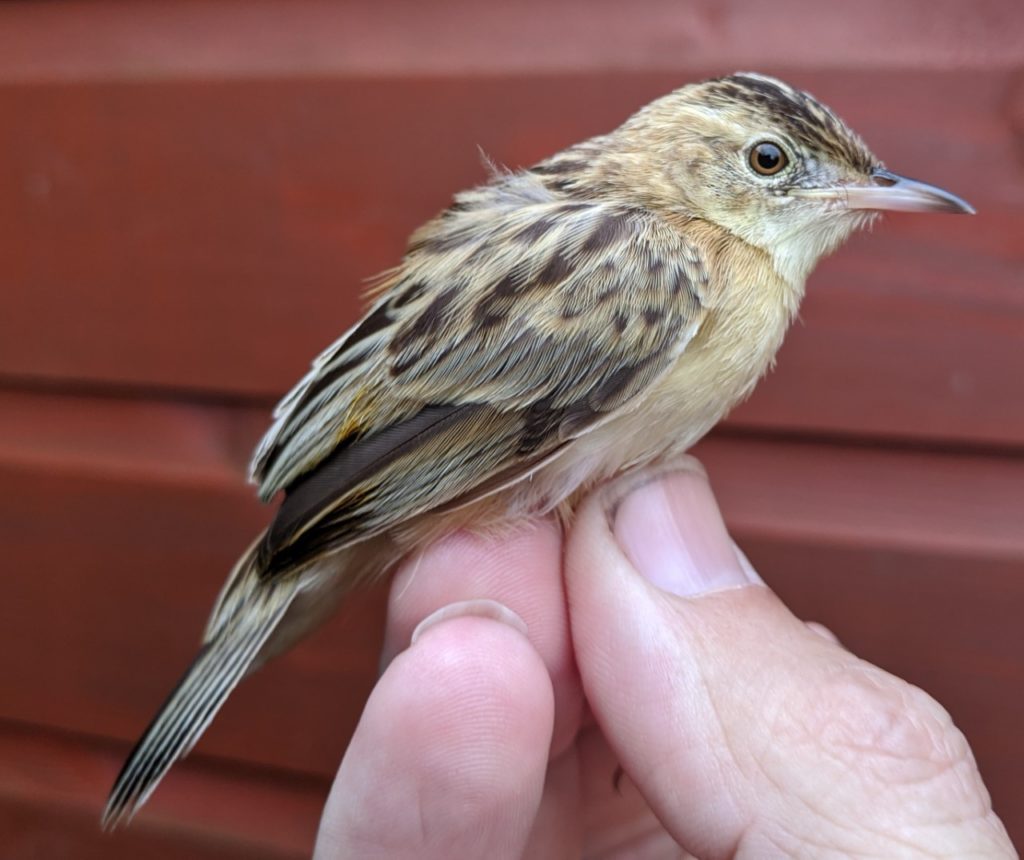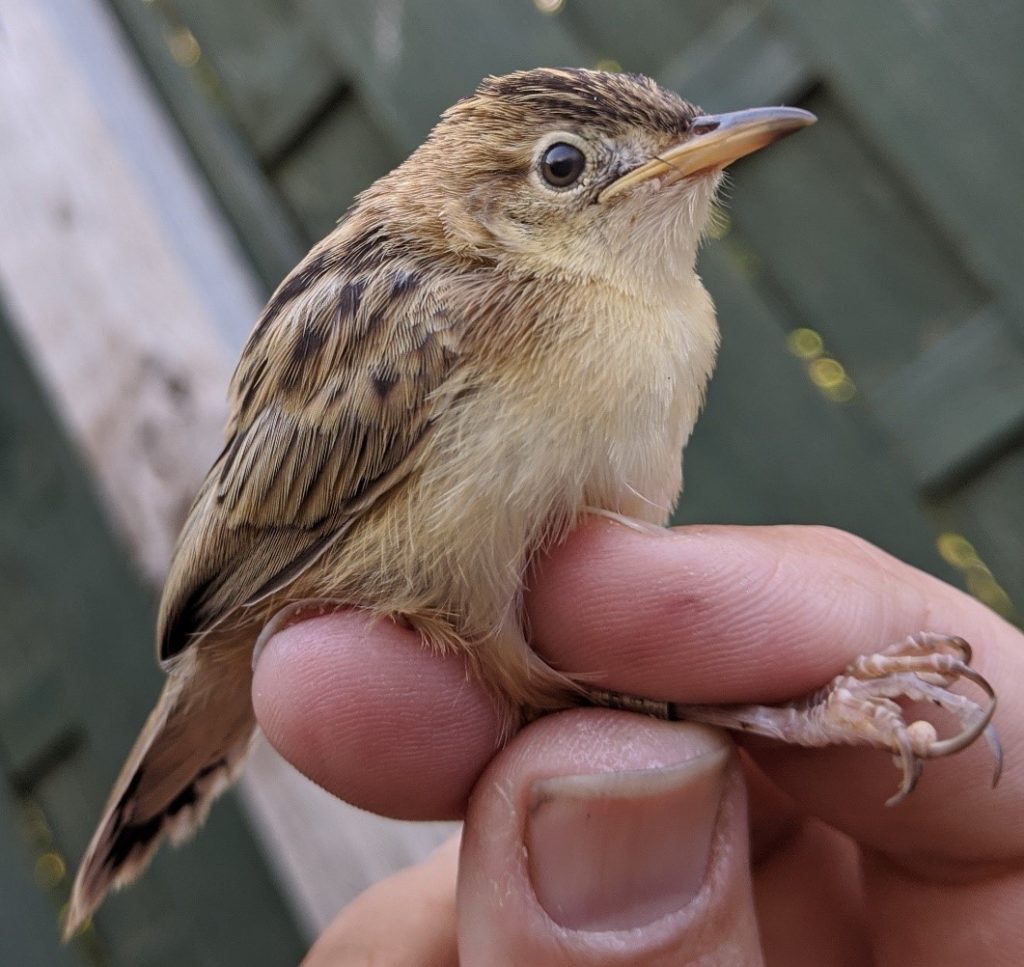There are certain species whose breeding range extends to the British Channel on the French side that many would suggest are likely to be the next to make the leap across the divide and begin to colonise mainland UK. Whilst some refer to one such species as fan-tailed Warbler, several authorities now list Cisticola juncidis as the Zitting Cisticola. If you’ve ever had the pleasure of watching a male performing his display flight then you may be more likely to stand behind the ‘zitting’ reference as these tiny birds emerge from their habitat and rise high into the air (in our case from Common Reed with sporadic Bramble bushes) they emit an unmistakable ‘Zit-Zit-Zit’ (likened to repeated snips of scissors) as they gain height which I would estimate is often in excess of 30 meters – the song remains clear but being so small they can become hard to spot. Though the range of the species extends along the French coast adjacent to Alderney (just 8 miles away) these birds are thought to suffer very badly in hard winters and as such the numbers in central and northern France can vary considerably from year to year.


First year bird ringed 04/09/20
Adult male bird ringed 27/04/20
Recently fledged bird ringed 29/07/20
With only 2 records across the Channel Islands prior to the year 2000 there has been a comparative recent flurry of sightings across Jersey and Guernsey. Local records in Alderney suggest the species likely to have bred in recent years but as yet I have been unable to pin down any details that evidence this success. Since the introduction of Alderney Bird observatory in 2016, its routine standardised census monitoring has produced the majority of Channel Islands records in recent years with up to 6 singing males present on Alderney in July 2017 and at least 5 the following year which included two males caught and ringed 5th of August and one re-trapped on the 7th. These tiny birds weigh in on average at around 9 grams with a closed wing measuring around 50mm, both statistics not dissimilar to those of a Wren.
The summer of 2019 saw 4 singing males at 3 separate locations but again females were notable by their absence, despite many hours in the field no breeding activity was observed. 2020 began differently with a single male present from the second week in March and singing from at least the 16th March. A second male offered competition at the same location just a week later on the 23rd. Both males were caught and ringed before the end of April and both were a regular sight ‘touting their wares’ throughout the spring.
The birds breeding site being within the observatory daily census recording area the spectacle of displaying male Cisticolas became routine as both birds were observed almost daily. Once again it seemed that females were going to be thin on the ground, but on the 15th May this all changed! On this particular morning during our census walk I had not heard a male singing but spotted a cisticola darting out of the reeds close to a public footway landing about 20 metres to my left on some Bramble. My camera always at the ready I snapped a couple of quick shots and on enlarging the pictures on the rear of the camera screen I could see this bird was carrying a large insect in its bill. All of a sudden, a second bird appeared on the same bush and the insect was passed between the two, the second bird promptly swallowed it! I took a few paces back putting a bit more distance between myself and the warblers, over the next few minutes I watched the same behaviour of the presumed male gifting another tasty catch to his apparent mate.

From a position of further retreat and with some excitement I watched the two birds again passing food, one bird was visiting a specific spot above the reeds and scrub where it would nose dive down into the undergrowth and disappear for up to thirty seconds at a time. Making a careful mental note of the location I felt confident that however far these two had progressed in pairing and nesting, things were looking very promising indeed. From here on spring assistant warden Elliot Monteith and I monitored the birds progress at a respectable distance. Given the nest location and that this was likely the only pair of this species nesting in the whole of the British Isles, I decided not to approach the nest in terms of nest recording or the ringing of any potential chicks, opting to wait and hopefully obtain some ringing data from fledged chicks further down the line. The nest was unnervingly close to a public footpath regularly used by dog walkers, access to the nest would have meant separating and stepping into the birds chosen ‘reedy/grassy area’ which would leave a conspicuous, if short, trail from the footway to the nest risking it being exposed to predators, there are rats in the vicinity and the occasional feral cat! The zitting cisticola’s nest is a cup shape with a canopy of tied-together leaves or grasses overhead for camouflage, the male builds the lions share of it and it is completed by the female. It is thought 3–6 eggs are laid. Females change their mates frequently and rarely stay within the same territory, this may go some way to explain why we have observed several males displaying in the same locations and this year, a second male bird continuing to display in close proximity to an active nesting pair. Given the birds continued obvious activity I felt that it was only a matter of time before these birds were discovered. After some deliberation I felt it the best option in the birds best interests that the ABO made a press release saying no more than a very rare Fan-tailed warbler was nesting on Alderney, and that no further information could be disclosed in order to give the birds every possible chance of success. Local wildlife legislation is a little different to that of the UK and the main thrust of the exercise was the opportunity to include a reminder to resident birders et al. that in Alderney (whilst there are certain exceptions for licenced researchers) it is a criminal offence to intentionally disturb the nest of breeding wild birds. The Protection of Wild Birds (Alderney) Ordinance, 2005 clearly states ‘ It shall not be lawful at any time to knowingly or wilfully to disturb eggs or nests of any wild bird’.
La Société Guernesiaise has a superb article that serves as a a code of conduct for bird watchers and photographers during the breeding season, we backed up our information sharing decision by including a link to this throughout our social media. Aside of the cisticolas, with thousands of active bird nests across the island it was a timely opportunity to help folk remember to help wildlife flourish, especially with so many people stuck at home due to covid-19 (now spending a lot of time in their gardens during a period where birds nests would in a normal year go undisturbed). To our enormous disappointment, a local individual actively sought out and discovered the cisticola nest, photographed it at close range going on to place photos of the actual nest, and name of the site where it was located onto multiple national social media forums! The disturbance to the habitat from the footway towards the nest location that I had so hoped to avoid was now evident. Local authorities acted quickly in terms of damage limitation to clamp down on the behaviour, and the sensitive ‘headline grabbing’ information was quickly removed from the public spotlight.
As an ex-police wildlife crime investigations officer, I have encountered the extreme lengths that some individuals will go to attempting to add the eggs of a rare British breeding bird to their display cabinet collections! Fortunately, those responsible having been ‘educated’ and with lockdown taking hold we escaped the possibility of any such unwelcome visitors from off island. For a spell, local Covid-19 restrictions then restricted our observations of the birds and we waited with great anticipation in the hope of seeing some fledged youngsters despite the saddening disturbance already undertaken. Finally, during a bird ringing session on 29th July I saw five Cisticolas occupying the same bush! They quickly dispersed all heading off together into cover but the brief views I managed using my Zeiss Victory 10×42’s were enough to confirm that at least two of the five were juveniles. Within an hour we had trapped and ringed a recently fledged Cisticola verifying beyond any doubt their breeding success. A second youngster was ringed at the same site on the 4th August and a 3rd on the 4th of September. A further un-ringed immature bird was observed on 9th September. A single male continues to display at the same site into the second week of September.
About Post Author
Visits on this Page:3160